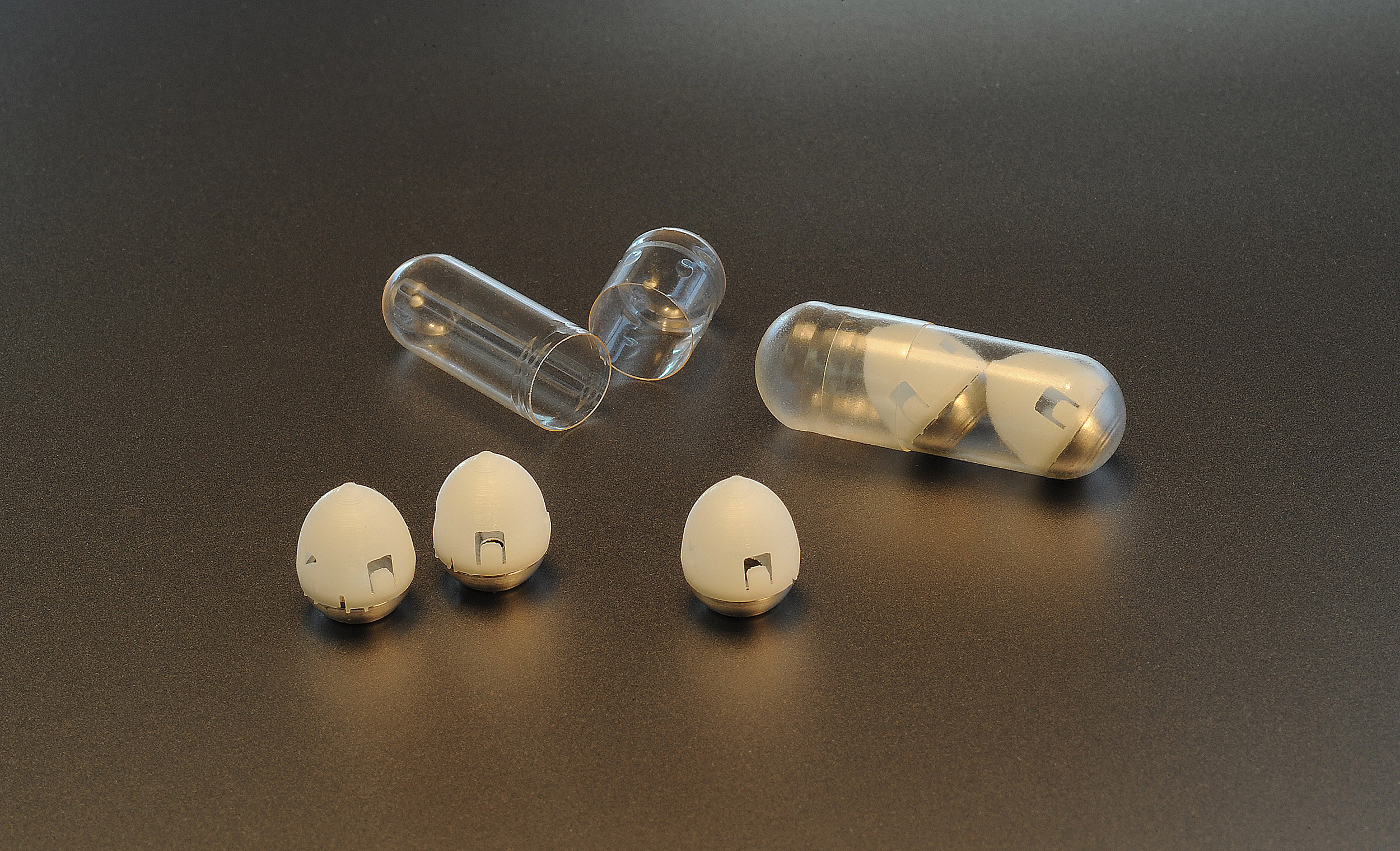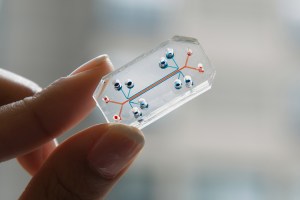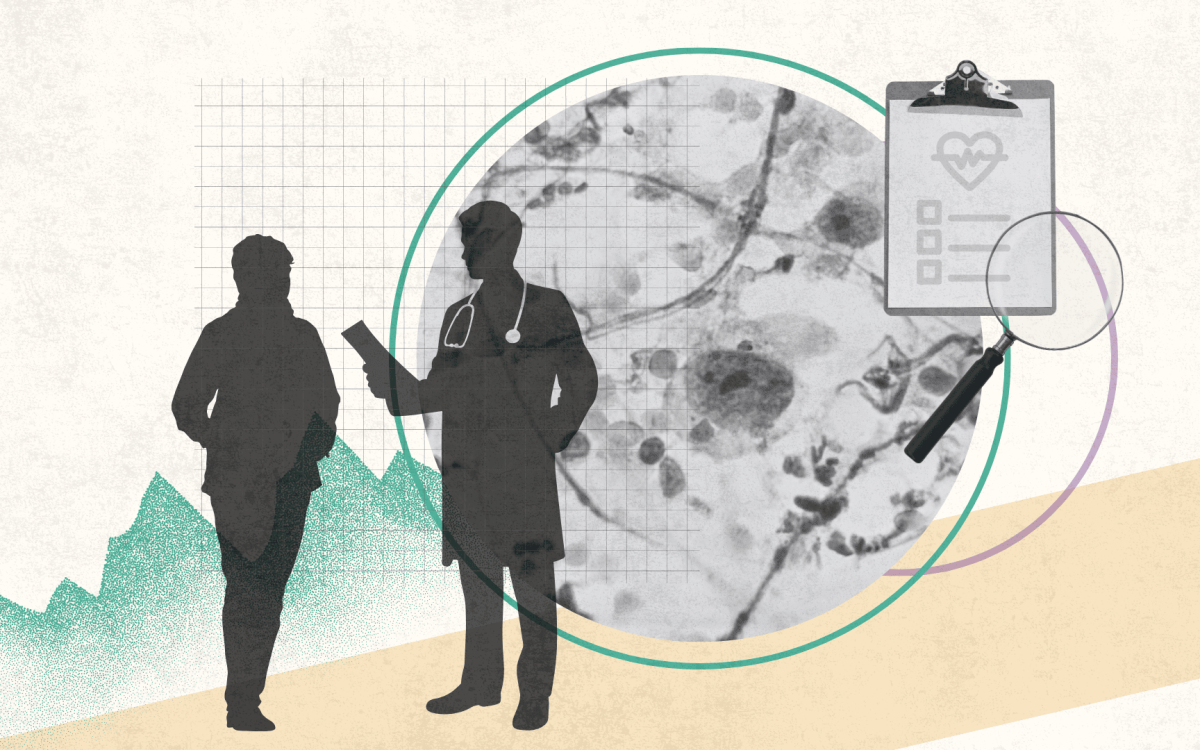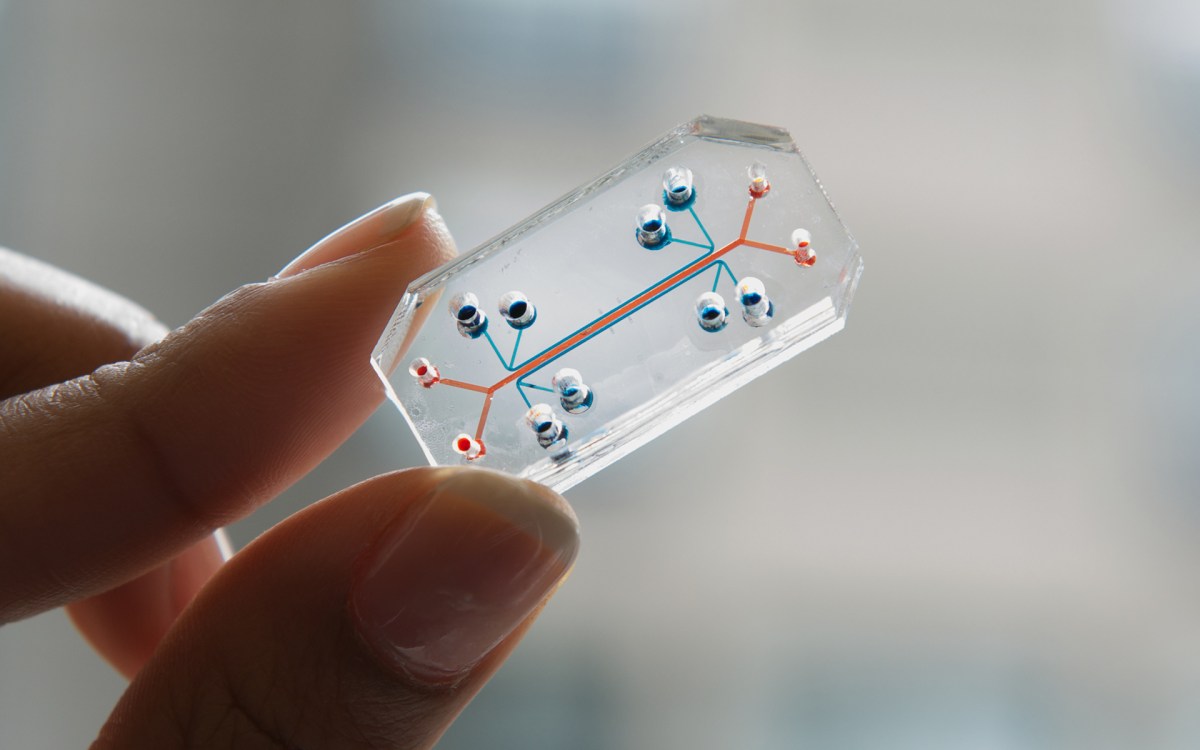
The ingestible microneedle is designed to inject insulin into the stomach lining. For size comparison, it is placed next to a capsule.
Photo by Felice Frankel
Microneedle pill takes the sting out of insulin
Tested in preclinical models, pea-size device delivers injection orally
For almost a century, patients with diabetes have relied on injectable insulin to manage their condition. And for nearly as long, researchers have pursued a way to orally administer insulin.
While insulin injections can be lifesaving, they are unpleasant, cumbersome, and increasingly expensive for patients, so health care providers often delay prescribing insulin injections in favor of less-effective oral medications. A team of investigators from Harvard-affiliated Brigham and Women’s Hospital, MIT, and Novo Nordisk has pioneered a new approach that brings closer to the clinic an oral formulation of insulin that can be swallowed rather than injected. With funding and in collaboration with scientists from Novo Nordisk, the team has developed an ingestible microneedle that can inject insulin into the stomach lining in a large animal model. Results are published in Science.
“The work described builds and is motivated by a few critical clinical observations, including, when a drug is injected into the stomach wall that drug can become distributed through the body very quickly. Moreover, we recognize that the stomach is insensate to sharp pain and very tolerant of small, sharp objects,” said co-corresponding author C. Giovanni Traverso, a gastroenterologist in the Division of Gastroenterology at the Brigham.
Traverso and colleagues had to overcome several challenges, including navigating extremes in pH, thick mucus layers, temperature, and reliable orientation for the microneedle to inject into the stomach lining. Their ingestible device, known as the self-orienting millimeter scale applicator, or SOMA, is inspired by the self-orienting leopard tortoise, a species that can flip itself over when on its back. The SOMA’s shape and density distribution were optimized so that the microneedle lands in the stomach in the same orientation every time.
Approximately the size of a pea, the SOMA houses a needle made of insulin and its injection is controlled by a spring held in place by a sugar disc. The sugar disc allows the humidity in the stomach to serve as the trigger of the micro-injection, and the solid insulin needle enables delivery of a sufficient dose of the drug. Its size and material makeup are similar to previously approved FDA ingestible devices.
The microneedle lands in the stomach in the same orientation every time.
Video by Xiaoya Lu
“The scientific principles underlying the SOMA system, and the system itself, have the potential to enable oral delivery of large molecules such as peptides, proteins, and nucleic acids,” said co-corresponding author Robert Langer, Institute Professor from the Harvard-MIT Division of Health Sciences and Technology. “This discovery has the potential to transform not only drug delivery, but drug discovery as well, since most current drug discovery efforts are aimed at creating small-molecule drugs that patients can take orally.”
More like this
Using pigs as a model system, the team administered microneedles loaded with 0.3 mg human insulin combined with poly(ethylene) oxide (PEO). They then measured how much of the insulin/PEO combination made it into the blood and also measured blood glucose levels in five animals. The team found a marked decrease in blood glucose levels, with similar active drug levels in the blood as when insulin was injected subcutaneously in five controls. The team saw no signs of tissue damage or abnormalities from the stomach injections, no signs of distress, and no changes in feeding or stool patterns.
Importantly, the authors note that the SOMA worked only in animals in a fasted state. They also note that further research will be required to determine the chronic effects of daily gastric injections.
“While additional study is needed, the SOMA represents a platform with the potential to deliver a multitude of drugs. Our results are encouraging and justify further evaluation of this technique for the oral delivery of insulin and other drugs,” said Traverso.
Other authors of this study include Alex Abramson, Ester Caffarel-Salvador, Minsoo Khang, David Dellal, David Silverstein, Yuan Gao, Morten Revsgaard Frederiksen, Andreas Vegge, František Hubálek, Jorrit J. Water, Anders V. Friderichsen, Johannes Fels, Rikke Kaae Kirk, Cody Cleveland, Joy Collins, Siddartha Tamang, Alison Hayward, Tomas Landh, Stephen T. Buckley, Niclas Roxhed, and Ulrik Rahbek.
This work was funded in part by a Novo Nordisk grant, NIH Grant No. EB-000244, an NSF GRFP fellowship, the Division of Gastroenterology at Brigham and Woman’s Hospital, the Viking Olaf Björk scholarship trust, and the MIT UROP program. Co-authors on the paper are employees of Novo Nordisk. Traverso and other co-authors are co-inventors on patent applications describing oral biologic drug delivery. Traverso and Langer report receiving consulting fees from Novo Nordisk.






